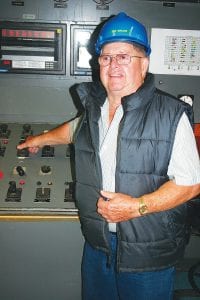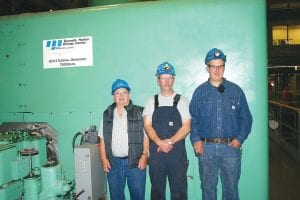Jim Schliep came “out of retirement” for the afternoon to lend a hand in taking Unit 3 off line for what might be the last time. Now owned by Minnesota Power, Taconite Harbor Energy Center was built by Erie Mining in the 1950s. Schliep helped with the installation of Unit 3 from 1965-67 and was a shift supervisor who oversaw operation of the unit, as well as the rest of the plant.

As his son Tim and grandson Jory looked on, Jim Schliep threw the switch to shut down Minnesota Power’s Taconite Harbor Energy Center Unit 3 coal-fired 75 megawatt electrical generator.
Unit 3 was taken off line at 4:20 p.m. on May 26, 2015. It had come on line May 27, 1967 and its first job was to produce 12 megawatts of electricity for Westinghouse.
It was the third time the unit has been shut down, but this time it was taken off line because of new Environmental Protection Agency (EPA) air emission rules, said Taconite Harbor Energy Center General Manager David Rannetsberger.
Schliep recalled, “When I started here there was nothing but dirt here.”
He worked two years for a construction company that helped build the power plant and loading dock for Erie Mining before being hired by the mining company.
Over the next 31 years Schliep wore many hats, working as a laborer on the dock and in the power plant before settling in as a shift maintenance supervisor.

For more than the last half century three generations of Schlieps have been helping to generate power for the northland at Taconite Harbor and they have been growing in stature. Standing next to Jim is his son Tim and grandson Jory. Tim and Jory walked Jim through the plant, showing him the many improvements Minnesota Power has made in equipment since purchasing the plant in 2001.
One of the biggest jobs he helped with was building Unit 3. Crews worked from 1965-67 to complete the unit. “It was a big job, a lot of hard work went into that project,” Schliep said.
He also ran Unit 3 as a shift supervisor, said Rannetsberger.
One of Schliep’s co-workers, Darwin Haveri was on hand for the shut down. When asked how long he had worked at the plant, Haveri looked at the back of his wristwatch, a gift from Erie for his years of service. “It says 38 years,” he said with a smile.
“My intentions were to work at Reserve [Mining],” said Haveri. “But I was 17, not old enough to get on at Reserve, and I was tired of making 50 cents an hour at the gas station so I applied and went to work at Murphy City on the railroad. We started with a 21-man crew and it grew to 37 before it eventually went down to six.”
The railroad Haveri referred to was the 23-milelong line between Aurora and Taconite Harbor that was built and owned by Erie.
Like Schliep, Haveri worked his way up from laborer to control room operator and then to a supervisor position. “I was the first apprentice from Erie to graduate from the maintenance mechanical correspondence course. It was supposed to take three years but I finished in 6½ months. When you finished one book and sent it in they would check your answers and send back another book right away. After awhile they sent me two books at once.”
Before Unit 3 was permanently silenced Rannetsberger gave a brief history about Erie.
Originally, said Rannetsberger, Erie planned to build six 75-megawatt coal-fired units to generate power for its mining operation in Aurora-Hoyt Lakes. “Their goal was to be completely self contained,” he said. “They planned to add more units as they grew, but after Unit 3 came on line they realized they didn’t need to generate any more power.”
In 1953 Erie began blasting rock to build a dock. Not long after they began building the harbor break wall. Barges were used to lift 325,000 tons of concrete in place between the two small islands that sit not far off shore to form a break wall. Before the harbor was finished it was sealed and drained, the bottom deepened and leveled to accommodate Great Lakes ships up to 1,000 feet in length.
Like today, ships brought in coal for the power plant. Haveri said it used to take up to 3½ days to unload 20,000 tons of coal. Today it takes about 36 hours to unload 60,000 tons of coal, said Rannetsberger.
By 1957 Units 1 and 2 were built and the first coal boat arrived in 1959. Together the two units could generate 150 megawatts.
A temporary trailer city was built between the lake and highway that held about 500 8-by-20 foot trailers. A restaurant and grocery store were put up and soon after, a town with 24 three- to four-bedroom houses was in place for permanent workers and their families.
The town of Taconite Harbor, said Rannetsberger, had its own ambulance, fire hall, church, ball fields, and playground. It was also filled with a lot of children who attended the Birch Grove Elementary School built by School District 166 in the early 1960s.
When asked how many people it took to build the facilities on the shore and on the hill 23 miles away in Aurora, Rannetsberger replied, “I don’t know. But at one time I heard there were 400 electricians working.”
By 1968 approximately 150 boats were loaded annually at the loading dock, the fastest, most efficient loading dock on the Great Lakes.
As for the power plant, a downturn in mining production and producing taconite pellets—a low grade ore that is mined, run through a concentrator and then pelletized– caused electric sales to fall and the power plant was shut down from 1982 to 1990. Meanwhile the town of Taconite Harbor shrank from 74 people in May 1986 to 12 in November 1987. The septic system failed and there was no money to fix it.
By June 1987 the town was empty and the last house was removed in 1990.
In between Erie Mining ran into financial trouble and in July 1986 declared Chapter 11 bankruptcy. LTV Steel purchased most of Erie’s holdings and during the restructuring many people were laid off. In 2001 LTV was forced into bankruptcy, but retained the dock and railroad.
The dock was closed in June 2001 and still remains shut down, although Rannetsberger said inquiries are still made into its potential availability.
Minnesota Power purchased the power plant in 2001. From 2007 to 2008 Minnesota Power spent over $50 million to retrofit Units 1 and 2 with new environmental emission controls, said Rannetsberger. He said that by the time the company was ready to upgrade Unit 3’s emissions, changes in the EPA rules had caused “prices to sky rocket.”
“We would have needed to double and triple the money to pay for emission controls for Unit 3 and that wasn’t economically possible.”
All told, said Rannetsberger, Minnesota Power has put more than $100 million into the power plant over the last 15 years.
Over the years, there were some accidents, a giant ash slide that crossed Highway 61, a bunker explosion, and two train derailments, said Rannetsberger. “But there have been a lot of improvements in safety.”
As for Schliep, he said was happy to have had a career at the plant. He noted that he and his wife, Mary, had raised “three good boys.” His son Tim and grandson Jory, on hand to help shut down Unit 3, both work at the energy center.
“As for these people who talk about this place causing asthma, I had asthma so bad when I was little they didn’t expect me to live. I never had problems working here. I’d like to talk to these people who say this place causes asthma because they don’t know anything about asthma,” said Schliep.
Haveri nodded. His son-in-law, Brian Sandman, head of production, was working somewhere in the plant. “This was a good place for me and for my son-in-law. He [Brian] started as a laborer and took advantage of every training they offered and look where he is now.
“I tell kids to take advantage of any on-thejob training they can get. It’s something they shouldn’t pass up.”
Recalling his days at the plant, Schliep nodded, “It was hard, but a good living.”


Loading Comments